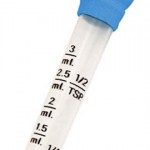 An article in Forbes.com by an ACSH advisor, Dr. Robert Glatter, an emergency physician on staff at Lenox Hill Hospital in New York City, called our attention to a recently-released policy statement issued by the AAP. The pediatrics academy took official notice of the fact that too many people caring for infants and children were following label directions calling for some fraction of teaspoons or tablespoons of liquid medication for little ones requiring such therapies.
An article in Forbes.com by an ACSH advisor, Dr. Robert Glatter, an emergency physician on staff at Lenox Hill Hospital in New York City, called our attention to a recently-released policy statement issued by the AAP. The pediatrics academy took official notice of the fact that too many people caring for infants and children were following label directions calling for some fraction of teaspoons or tablespoons of liquid medication for little ones requiring such therapies.
The new metric dosing guidelines, set forth in the AAP report, represent an important effort to increase the safety of dispensing medications to children. They are now urging not only parents and caregivers, but medical providers and pharmacists, to use only one method of measuring out medications the metric system using milliliters or mls.
According to Dr. Glatter and the AAP, Using the metric system is the most accurate way to measure doses of medications in order to avoid an unintentional overdose. In fact, thousands of children are seen and evaluated in the emergency department annually for such a scenario. The ultimate cause is often unclear instructions for measuring, which are often specified as fractions of teaspoons.
While many parents and caregivers believe they can accurately measure out medications using half or quarter teaspoons, the truth is that there is variability each time dosing occurs. The end result may lead to progressive overdosing of medications which can have dangerous side effects.
Beside this, some caregivers may inadvertently use a tablespoon instead of a teaspoon to measure out doses, placing children at high risk for unintentional overdoses. This could potentially lead to three times the dose of a particular medication being given to a child, placing them at high risk for adverse outcomes.
He mentions two of the most commonly prescribed and most commonly overdosed medications, tylenol (acetaminophen) and benadryl (diphenhydramine), as common causes of infants ER visits. These could be reduced substantially by parents, doctors, and other caregivers adherence to the AAP guidelines and sticking with the metric dosage system.


